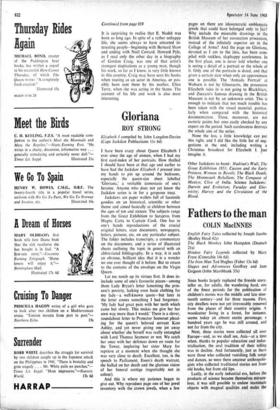As we liked it
JOHN GIELGUD
The House of Arden E. Nesbit (Dent 21s) Lewis Carroll, E. Nesbit and Howard Pyle Roger Lancelyn Green, Arthur Bell and Elizabeth Nesbitt (Bodley Head 25s) I have recently been absorbed in rereading three favourite novels of my youth—Great Expectations, Compton Mackenzie's Sinister Street and E. Nesbit's Five Children and It —trying to form a more critical adult view of them after nearly fifty years, and to judge their merits apart from the nostalgic associa- tions of my boyhood.
E. Nesbit's The House of Arden was com- pletely new to me, however, and I was delighted to find the story characteristically refreshing and attractive, if somewhat more elaborate and therefore less cosy than her earlier books. But I cannot help missing the hand of H. R. Millar, whose unforgettable illustrations to the other Nesbit stories are so vividly apt—almost as inimitable (perhaps more so because of one's childhood loyalties) as Cruickshank's are to Dickens. The present House of Arden illustra- tions are a poor substitute, and I wonder if Millar made some for the original edition.
Excitement and suspense are admirably sus- tained all through the story; sentimentality, though not entirely absent, is kept on a tight rein, and the dialogue dates surprisingly little, even though the book was written in 1908. Only the episode of the camera and the developing of the photographs may cause modern children, brought up on Leicas and Polaroids, to raise their small eyebrows in some surprise. The Mouldiwarp is, in my view, something of an understudy for the delightful Psammead in Five Children. But the rows between the children and their magic journeys (driving through the air in a swan carriage swathed in pigeons-feather fur coats) are as imaginative as ever—though I am less convinced by the stage language of the historical characters, who seem suddenly to belong to the world of Harrison Ainsworth. Much of the dialogue, however, is irresistible—especially the verse in- vented by the children to summon the Mouldi- warp, and such Alice-like passages as: ' "It was such a long climb too; it seems as though it would last for ever." "I've heard of foreign climbs," said Elfrida, "but I never thought they would be like this. I suppose it is foreign." ' The leisured background of all E. Nesbit's stories cannot fail to charm those of us old enough to remember it. Nannies and parlour- maids, traps to the station, nursery meals, and grown-ups disappearing to pay calls and stay with relations, 'goodies from the big house' for the villagers, amiable country clergymen and yokels—but I doubt if modern children will miss telephones and aeroplanes, radio sets and television, while they follow these adventures told with such fresh, humorous perceptiveness.
Three excellent monographs, by three different authors, one of them on E. Nesbit herself, along with essays on Lewis Carroll and the American illustrator Howard Pyle, have also been recently republished in a single volume. Roger Lancelyn Green seems to prove very convincingly that Carroll's appalling stam- mer may account for his extreme predilection for the company of small children—perhaps he did not stammer (as is the case with some actors) when he was reciting one of his stories.
Continued on page 822 Continued from page 819
It is surprising to realise that E. Nesbit was born so long ago. In spite of a rather unhappy life, she seems always to have attracted in- teresting people—beginning with Bernard Shaw and ending with Noel Coward. Howard Pyle, as I read only the other day in a biography of Gordon Craig, was one of that artist's strongest inspirations as a young man, though his work, so far as I know, is very little known in this country. Craig may have seen his books when touring as an actor in America, or pos- sibly been sent them by his mother, Ellen Terry, when she was acting in the States. The account of his life and work is also most interesting.











































 Previous page
Previous page